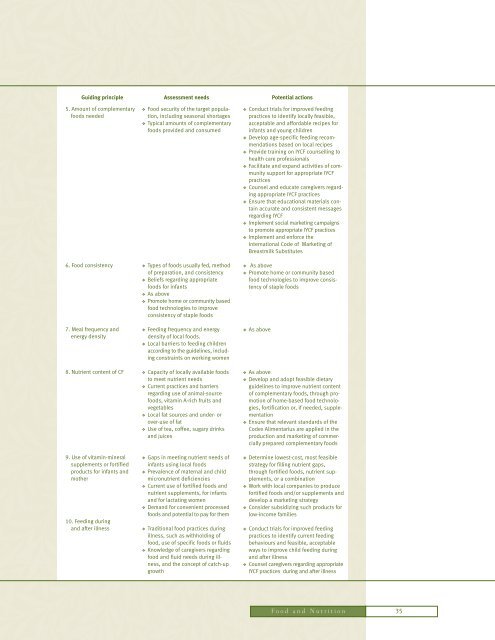Guiding Principles for Complementary Feeding of the Breastfed
Guiding Principles for Complementary Feeding of the Breastfed
Guiding Principles for Complementary Feeding of the Breastfed
You also want an ePaper? Increase the reach of your titles
YUMPU automatically turns print PDFs into web optimized ePapers that Google loves.
<strong>Guiding</strong> principle Assessment needs Potential actions<br />
5. Amount <strong>of</strong> complementary<br />
foods needed<br />
6. Food consistency<br />
7. Meal frequency and<br />
energy density<br />
8. Nutrient content <strong>of</strong> CF<br />
9. Use <strong>of</strong> vitamin-mineral<br />
supplements or <strong>for</strong>tified<br />
products <strong>for</strong> infants and<br />
mo<strong>the</strong>r<br />
10. <strong>Feeding</strong> during<br />
and after illness<br />
❖ Food security <strong>of</strong> <strong>the</strong> target population,<br />
including seasonal shortages<br />
❖ Typical amounts <strong>of</strong> complementary<br />
foods provided and consumed<br />
❖ Types <strong>of</strong> foods usually fed, method<br />
<strong>of</strong> preparation, and consistency<br />
❖ Beliefs regarding appropriate<br />
foods <strong>for</strong> infants<br />
❖ As above<br />
❖ Promote home or community based<br />
food technologies to improve<br />
consistency <strong>of</strong> staple foods<br />
❖ <strong>Feeding</strong> frequency and energy<br />
density <strong>of</strong> local foods.<br />
❖ Local barriers to feeding children<br />
according to <strong>the</strong> guidelines, including<br />
constraints on working women<br />
❖ Capacity <strong>of</strong> locally available foods<br />
to meet nutrient needs<br />
❖ Current practices and barriers<br />
regarding use <strong>of</strong> animal-source<br />
foods, vitamin A-rich fruits and<br />
vegetables<br />
❖ Local fat sources and under- or<br />
over-use <strong>of</strong> fat<br />
❖ Use <strong>of</strong> tea, c<strong>of</strong>fee, sugary drinks<br />
and juices<br />
❖ Gaps in meeting nutrient needs <strong>of</strong><br />
infants using local foods<br />
❖ Prevalence <strong>of</strong> maternal and child<br />
micronutrient deficiencies<br />
❖ Current use <strong>of</strong> <strong>for</strong>tified foods and<br />
nutrient supplements, <strong>for</strong> infants<br />
and <strong>for</strong> lactating women<br />
❖ Demand <strong>for</strong> convenient processed<br />
foods and potential to pay <strong>for</strong> <strong>the</strong>m<br />
❖ Traditional food practices during<br />
illness, such as withholding <strong>of</strong><br />
food, use <strong>of</strong> specific foods or fluids<br />
❖ Knowledge <strong>of</strong> caregivers regarding<br />
food and fluid needs during illness,<br />
and <strong>the</strong> concept <strong>of</strong> catch-up<br />
growth<br />
❖ Conduct trials <strong>for</strong> improved feeding<br />
practices to identify locally feasible,<br />
acceptable and af<strong>for</strong>dable recipes <strong>for</strong><br />
infants and young children<br />
❖ Develop age-specific feeding recommendations<br />
based on local recipes<br />
❖ Provide training on IYCF counselling to<br />
health care pr<strong>of</strong>essionals<br />
❖ Facilitate and expand activities <strong>of</strong> community<br />
support <strong>for</strong> appropriate IYCF<br />
practices<br />
❖ Counsel and educate caregivers regarding<br />
appropriate IYCF practices<br />
❖ Ensure that educational materials contain<br />
accurate and consistent messages<br />
regarding IYCF<br />
❖ Implement social marketing campaigns<br />
to promote appropriate IYCF practices<br />
❖ Implement and en<strong>for</strong>ce <strong>the</strong><br />
International Code <strong>of</strong> Marketing <strong>of</strong><br />
Breastmilk Substitutes<br />
❖ As above<br />
❖ Promote home or community based<br />
food technologies to improve consistency<br />
<strong>of</strong> staple foods<br />
❖ As above<br />
❖ As above<br />
❖ Develop and adopt feasible dietary<br />
guidelines to improve nutrient content<br />
<strong>of</strong> complementary foods, through promotion<br />
<strong>of</strong> home-based food technologies,<br />
<strong>for</strong>tification or, if needed, supplementation<br />
❖ Ensure that relevant standards <strong>of</strong> <strong>the</strong><br />
Codex Alimentarius are applied in <strong>the</strong><br />
production and marketing <strong>of</strong> commercially<br />
prepared complementary foods<br />
❖ Determine lowest-cost, most feasible<br />
strategy <strong>for</strong> filling nutrient gaps,<br />
through <strong>for</strong>tified foods, nutrient supplements,<br />
or a combination<br />
❖ Work with local companies to produce<br />
<strong>for</strong>tified foods and/or supplements and<br />
develop a marketing strategy<br />
❖ Consider subsidizing such products <strong>for</strong><br />
low-income families<br />
❖ Conduct trials <strong>for</strong> improved feeding<br />
practices to identify current feeding<br />
behaviours and feasible, acceptable<br />
ways to improve child feeding during<br />
and after illness<br />
❖ Counsel caregivers regarding appropriate<br />
IYCF practices during and after illness<br />
Food and Nutrition<br />
35

















